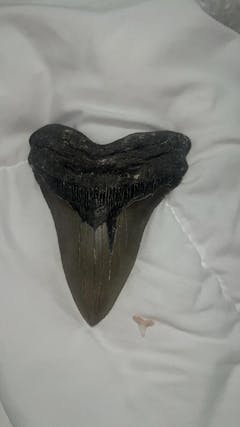Item Specifics:
Species: Carcharocles megalodon
Location: Savannah, Georgia
Age: Pliocene-Miocene (3-15 million years old)
Size: 3.68” Width: 2.70”
Item: Meg #1564
Authentic 3.68" Megalodon Tooth – Fossil Shark Tooth from Savannah, Georgia
Own a stunning fossilized Megalodon tooth sourced from the ancient, alligator- and shark-infested rivers near Savannah, Georgia! Measuring 3.68 inches long by 2.70 inches wide, this genuine Carcharocles megalodon tooth is a powerful relic from the Pliocene-Miocene epoch, dating back 3 to 15 million years.
These riverbeds are well known among fossil hunters for producing richly mineralized Megalodon teeth with dark hues, strong roots, and sharp serrations. Fossils from this region are admired for their natural preservation and striking appearance, making them highly collectible.
Key Features:
✔ Species: Carcharocles megalodon
✔ Location: Savannah, Georgia
✔ Size: 3.68" length x 2.70" width
✔ Age: Pliocene-Miocene (approx. 3–15 million years)
✔ Condition: 100% Natural – No repair or restoration
✔ Perfect for: Fossil collectors, shark enthusiasts, history buffs, and educators
✔ Display-Ready: Ideal for showcasing in fossil displays, study desks, or gift collections
Why This Savannah Megalodon Tooth Is Special:
This authentic Megalodon tooth features exceptional enamel preservation, a solid root, and distinct serrations, all packed into a perfectly sized specimen for collectors. Teeth from Savannah’s rivers are relatively rare and often stand out with their deep coloration and natural wear that adds character.
Whether you're building a display or gifting a meaningful piece of Earth's history, this tooth is a conversation starter and a lasting addition to any fossil collection.
Authenticity & Buyer Confidence:
🔹 100% Natural Fossil – Guaranteed no repairs or restorations
🔹 Expert Identification – Verified by experienced fossil dealers
🔹 30-Day Returns – Full refund (minus shipping) if not satisfied
🔹 Combined Shipping Available – Save on multiple items
🔹 International Shipping – Buyers are responsible for applicable import duties or taxes
Own a Piece of the Prehistoric Ocean’s Apex Predator
The Megalodon, the largest shark to ever live, could grow over 60 feet long, with teeth reaching up to 7 inches. This 3.68-inch fossil tooth from Savannah, Georgia, is a genuine relic from that ancient giant, offering a unique blend of scientific intrigue, collector value, and natural beauty.
🦈 Don’t miss your opportunity to own this authentic Megalodon tooth fossil. Add a rare piece of prehistoric marine history to your collection today!
🦈 About Megalodon and Fossil Megalodon Shark Teeth
The Megalodon shark (Otodus megalodon) is widely considered the most formidable predator to have ever lived. Dominating the oceans during the Miocene and early Pliocene epochs — approximately 3.6 to 15 million years ago — Megalodon was the undisputed apex predator of its time. With estimated lengths of up to 60 feet (18 meters) and a body mass of over 50 tons, it was more than three times longer than the largest recorded Great White Shark and up to 25 times heavier. Its jaw alone could span over 10 feet, lined with rows of serrated, triangular teeth designed to shear through flesh and bone with ease.
Unlike bones, shark skeletons are made primarily of cartilage, which doesn't fossilize well. What survives today are the Megalodon’s fossilized teeth, which have become one of the most iconic and sought-after fossils in the world. These ancient teeth are incredibly durable and can range from just under an inch to a massive 7 inches in length. Some of the most prized examples feature sharp serrations, glossy enamel, and full, unbroken roots — indicators of high-quality preservation.
Fossil Megalodon teeth are discovered in sedimentary marine deposits on every continent except Antarctica. In the United States, top fossil-hunting grounds include Florida’s Bone Valley, South Carolina’s Lowcountry, North Carolina’s coastal rivers, and parts of California’s coastal cliffs. Internationally, countries like Morocco, Peru, Indonesia, and Japan are also rich in Miocene and Pliocene-aged deposits that yield Megalodon teeth of various sizes and colors.
What Makes a Megalodon Tooth Valuable?
Not all Megalodon teeth are created equal. Several key factors influence their collectible value:
-
Size: Teeth over 5 inches are significantly rarer than smaller ones and increase in value exponentially with every tenth of an inch.
-
Condition: Complete enamel, well-defined serrations, intact roots, and a visible bourlette (the darker triangular band near the root) are all indicators of exceptional quality.
-
Color: Fossil teeth can absorb minerals from their surrounding environment during fossilization. As a result, they appear in a wide array of hues — from black, gray, and brown to more rare and exotic colors like blue, red, tan, and even green.
-
Origin: Some localities are more scarce or have been collected out, increasing the value of teeth from those areas. For example, fossil teeth from Chile and certain regions of Peru are highly prized and now much harder to come by.
Why Collect Fossil Megalodon Teeth?
Owning a Megalodon tooth is like holding a piece of deep time — a preserved remnant from an ancient world that predates modern humans by millions of years. These fossils are prized not just by collectors but also by educators, museums, scientists, and gift-givers looking for something truly extraordinary.
-
Educational Value: Megalodon teeth are used to teach about evolution, paleontology, ocean ecosystems, and extinction events.
-
Gift Appeal: These fossils make unforgettable gifts for shark lovers, science enthusiasts, and fossil collectors of all ages.
-
Investment: As demand continues to grow and high-quality specimens become more difficult to source, fossil Megalodon teeth remain a strong collectible and investment item.
At Fossil Driven, we are passionate about fossils and committed to offering only authentic, 100% natural Megalodon teeth. Every specimen we sell is verified for authenticity with no repair or restoration — just a genuine piece of Earth’s ancient past, preserved for millions of years and ready to be treasured for generations to come.


















